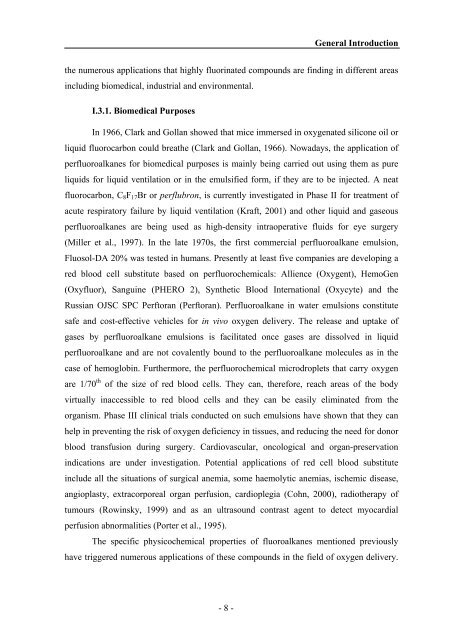n - PATh :.: Process and Product Applied Thermodynamics research ...
n - PATh :.: Process and Product Applied Thermodynamics research ...
n - PATh :.: Process and Product Applied Thermodynamics research ...
You also want an ePaper? Increase the reach of your titles
YUMPU automatically turns print PDFs into web optimized ePapers that Google loves.
General Introduction<br />
the numerous applications that highly fluorinated compounds are finding in different areas<br />
including biomedical, industrial <strong>and</strong> environmental.<br />
I.3.1. Biomedical Purposes<br />
In 1966, Clark <strong>and</strong> Gollan showed that mice immersed in oxygenated silicone oil or<br />
liquid fluorocarbon could breathe (Clark <strong>and</strong> Gollan, 1966). Nowadays, the application of<br />
perfluoroalkanes for biomedical purposes is mainly being carried out using them as pure<br />
liquids for liquid ventilation or in the emulsified form, if they are to be injected. A neat<br />
fluorocarbon, C8F17Br or perflubron, is currently investigated in Phase II for treatment of<br />
acute respiratory failure by liquid ventilation (Kraft, 2001) <strong>and</strong> other liquid <strong>and</strong> gaseous<br />
perfluoroalkanes are being used as high-density intraoperative fluids for eye surgery<br />
(Miller et al., 1997). In the late 1970s, the first commercial perfluoroalkane emulsion,<br />
Fluosol-DA 20% was tested in humans. Presently at least five companies are developing a<br />
red blood cell substitute based on perfluorochemicals: Allience (Oxygent), HemoGen<br />
(Oxyfluor), Sanguine (PHERO 2), Synthetic Blood International (Oxycyte) <strong>and</strong> the<br />
Russian OJSC SPC Perftoran (Perftoran). Perfluoroalkane in water emulsions constitute<br />
safe <strong>and</strong> cost-effective vehicles for in vivo oxygen delivery. The release <strong>and</strong> uptake of<br />
gases by perfluoroalkane emulsions is facilitated once gases are dissolved in liquid<br />
perfluoroalkane <strong>and</strong> are not covalently bound to the perfluoroalkane molecules as in the<br />
case of hemoglobin. Furthermore, the perfluorochemical microdroplets that carry oxygen<br />
are 1/70 th of the size of red blood cells. They can, therefore, reach areas of the body<br />
virtually inaccessible to red blood cells <strong>and</strong> they can be easily eliminated from the<br />
organism. Phase III clinical trials conducted on such emulsions have shown that they can<br />
help in preventing the risk of oxygen deficiency in tissues, <strong>and</strong> reducing the need for donor<br />
blood transfusion during surgery. Cardiovascular, oncological <strong>and</strong> organ-preservation<br />
indications are under investigation. Potential applications of red cell blood substitute<br />
include all the situations of surgical anemia, some haemolytic anemias, ischemic disease,<br />
angioplasty, extracorporeal organ perfusion, cardioplegia (Cohn, 2000), radiotherapy of<br />
tumours (Rowinsky, 1999) <strong>and</strong> as an ultrasound contrast agent to detect myocardial<br />
perfusion abnormalities (Porter et al., 1995).<br />
The specific physicochemical properties of fluoroalkanes mentioned previously<br />
have triggered numerous applications of these compounds in the field of oxygen delivery.<br />
- 8 -



